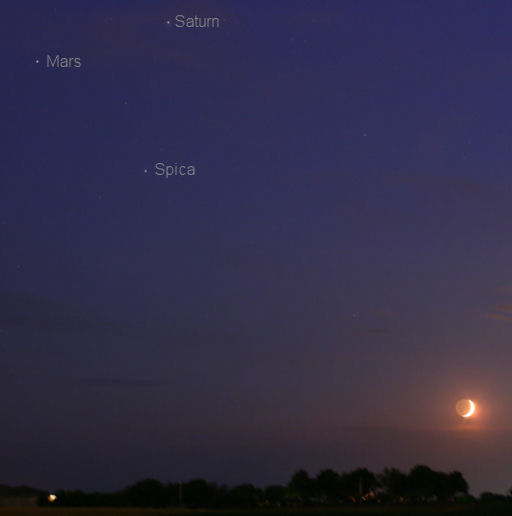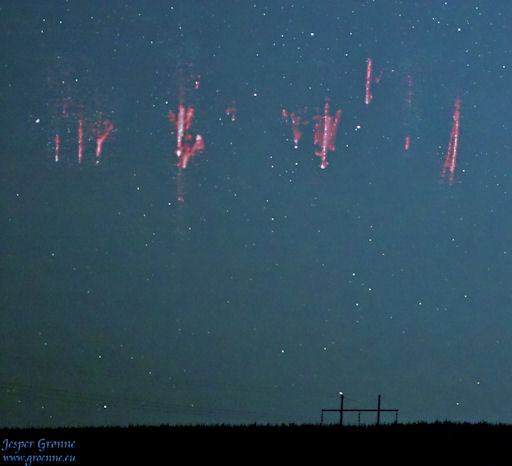Listen to radar echoes from satellites and meteors, live on listener-supported Space Weather Radio. | | |
QUIET SUN: After a brief spate of M-class solar flares over the weekend, solar activity has returned to low levels. NOAA forecasters estimate no more than a 15% chance of more M-flares today. Solar flare alerts: text, phone.
SUNSET GATHERING: The "Martian Triangle" is back. You can see it tonight beaming through the twilight in the southwestern sky after sunset. The triangle is a triple conjunction of Mars, Saturn, and blue-giant star Spica--last seen by most people on Aug. 5th when Curiosity landed on Mars. Bonus: the crescent Moon is there, too. Don't miss it! [sky map]
Last night, Doug Zubenel took this picture of the Moon approaching the Martian Triangle over the Kansas prairie:

More images of the gathering may be found in our realtime photo gallery:
Realtime Space Weather Photo Gallery
RED SPRITES: High above Earth in the realm of meteors and noctilucent clouds, a strange and beautiful form of lightning dances at the edge of space. Researchers call the bolts "sprites"; they are red, fleeting, and tend to come in bunches. Jesper Grønne of Silkeborg, Denmark, photographed these specimens on August 15th:

"After several years of hunting sprites from my location in Denmark, I finally caught some last week--the first danish Red Sprites ever photographed," says Grønne. "They were located 50 km to 90 km above a thunderstorm some 350 km away over the North Sea. There were 2 flashes, each producing 5-6 individual Red Sprites."
"Sprites are a true space weather phenomenon," explains lightning scientist Oscar van der Velde of Sant Vicenç de Castellet, Spain. "They develop in mid-air around 80 km altitude, growing in both directions, first down, then up. This happens when a fierce lightning bolt draws lots of charge from a cloud near Earth's surface. Electric fields [shoot] to the top of Earth's atmosphere--and the result is a sprite. The entire process takes about 20 milliseconds."
Although sprites have been seen for at least a century, most scientists did not believe they existed until after 1989 when sprites were photographed by cameras onboard the space shuttle. Now "sprite chasers" routinely photograph sprites from their own homes. "I used an astro-modified Canon 5D II in video-mode to catch my sprites," says Grønne. Give it a try!
diagram: How to Look for Sprites (used with permission of sky-fire.tv)
Realtime Aurora Photo Gallery
Realtime Noctilucent Cloud Photo Gallery
[previous years: 2003, 2004, 2005, 2006, 2007, 2008, 2009, 2011]

